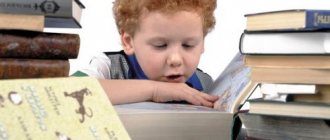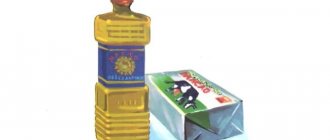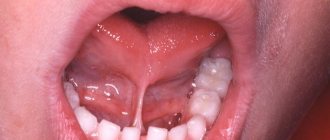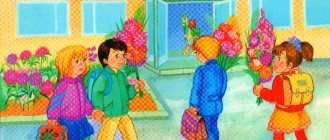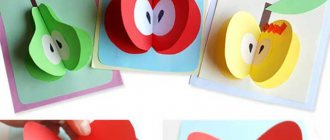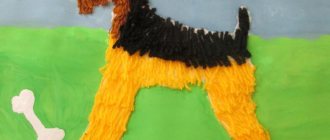Songs to learn the alphabet - video
Songs help you learn the alphabet and remember letters faster and easier. To a cheerful, simple melody, the characters sing about the letters, arranged in the same order as in the alphabet. Get your child interested in the video and offer several options to choose from. Let the child choose the song himself.
If the child is attentive and not only listens, but also watches the video series, choose a song with bright pictures and memorable characters.
your child often get distracted while watching ? A song with only lyrics is enough.
Tip : You can listen and watch videos every day in the first half of the day, when information is perceived easier and faster.
Let's sculpt.
A very useful activity is to sculpt letters from colored dough or plasticine. And if you combine sculpting with listening to Ekaterina Zheleznova’s songs from the album “Musical Primer” (in which the whole sculpting process is “sung” in a very interesting way), then sculpting will be even more fun.
Wonderful mothers, passionate about the development of children, have long made funny videos from these songs and posted them online.
For example, while playing and watching a funny video, you can make the letter A in a fun and interesting way:
Tilt two sticks
Connect at the top
One crossbar -
Like a letter A tent!
Exercises to strengthen and develop the speech apparatus
Often, a child pronounces sounds incorrectly because his speech apparatus muscles are poorly developed. Speech therapists offer exercises aimed at strengthening this muscle group. You need to start doing them from the age of 3-4 , so that by the age of 6-7 the child does not have any problems with speech.
- Exercises to strengthen the muscles of the tongue help pronounce the letters “c”, “ch”, “t”, “r”, “sh”, “zh”.
- “Sting” - tense your tongue as much as possible, stick it out and stay in this position for as long as possible.
- “Spatula” - place the tongue on the lower lip.
- “Bowl” - open your mouth, stick out your tongue, do not touch your teeth, stick it back.
- “Pendulum” - open your mouth, stick out your tongue, tense, and move left and right.
- “Horse” , “turkey” - the baby should imitate the clatter of hooves, as well as the cry of a turkey (bl-bl-bl).
- Exercises to strengthen the root of the tongue help to correctly pronounce the sounds “g”, “k”, “x”.
- slight cough;
- imitation of sounds when gargling;
- pronunciation of the vowels “a”, “i”, “e”, but sharply, abruptly.
- Correct closing of the lips helps to pronounce the sounds “b”, “m”, “p”.
- Squeeze the pencil between your lips and describe a circle in the air with it.
- Squeeze a bean or seed with your lips and then sharply spit it out.
- Show how a horse snorts.
- Imitation of drum sounds - boom, bam.
- Cheek training.
- Take turns puffing out your cheeks.
- Puff out your cheeks and imitate chewing food.
- Roll air from one cheek to another.
Fine motor skills help in speech development. Massage your baby's palms regularly. You can use soft brushes, balls, and say jokes for this. Applications, stringing of beads, modeling from plasticine or salt dough are great for developing fine motor skills.
Letter eater.
A cheerful Bukvoeshka may appear in your home. The easiest way to do this is to take a glove doll or a soft toy.
For example, this cockerel -
very unusual! He eats letters! Come on! Let him eat the letter B! And now he wants the letter A! Oh, how deliciously you feed the cockerel!
You can play the letter game in another way:
Funny people live in this box. They eat nothing but letters. Let's feed them? (the little people’s mouths are slits in the box).
Here is their food (we draw letters on the beans with a felt-tip pen):
We feed the little men (each little man has his own letter, if the baby makes a mistake, the little men spit merrily, close their mouths and demand to be fed another food that suits them better (beans with “their” letter):
How to learn the alphabet online - 5 proven simulators
When a baby learns the alphabet with a tablet in his hands, the information is remembered more easily, because the child is completely focused on the bright picture. We have selected for you several interesting applications that can be downloaded to your tablet and offered to your child as an alternative to books and posters.
Talking ABC - Alphabet
The application has free and paid content, the tasks are all clear and accessible. In addition, the exercises differ in difficulty level. The kid will be able not only to learn the letter, but also to color it. The application is free, but you can also purchase the full version.
ABC for children
The child learns all the letters of the alphabet from bright pictures. The application interface is simple, accessible, and has sound. Learning occurs not only through pictures, but also through riddles. The application is free.
«Alphabet. Let's learn letters. «
This application is suitable even for the little ones. Especially if your child loves dinosaurs. You can study together with your child - you on the phone, for example, he on the tablet.
ABC coloring book
A real find for children who love to draw. In this application, the baby learns letters, gets acquainted with their writing and shows his creative abilities. An excellent educational game for those who are getting acquainted with the alphabet and are already learning to read. The application is free.
Letters: learning to read is fun
First, the child learns the interactive alphabet, and then can play with the letters. To do this, he needs not only to name the letter, but also to pronounce the sound, and then name the object whose name begins with this letter. The short version of the application is free, the full version is paid.
Halves is a game to consolidate knowledge about already familiar letters.
In the process of learning the alphabet, the process of repetition is important. Still would! After all, by the time you get to “I”, you must try not to forget the letter “A”.
The process of repeating already learned material will be more fun with the game “Halves”!
Cut out beautiful cards with letters, cut them into two parts, mix them.
Invite your child to “fold” letters from two halves.
Talking ABC - poster for learning the alphabet at home
We have prepared for you a review of the most interesting and fascinating alphabet posters. Choose a poster where a voice pronounces the letter and sound. It is important that the child understands the difference between them. Be patient, support the child in everything, help him.
- Talking ABC Expert. This poster contains letters, poems, songs, and the voiceover is clear and understandable.
- ABC. Farm and zoo. Here the child will find fairy tales, letters, numbers, geometric shapes, animal names. The poster is bright, engaging, and the sound is clear and loud.
- Poster Pushkin and Russia. ABC. The canvas depicts characters from the works of Alexander Sergeevich Pushkin, they read poetry, professional voice acting is used. The buttons respond well to pressing and have an auto-off function.
- Safety poster. Azbukvarik . – the poster introduces children not only to letters and sounds, but also to the rules of the road. Very colorful, useful and durable.
- ABC of child safety. Connoisseur. The poster teaches useful and necessary things in life - politeness, correct behavior and, of course, the alphabet. There is a knowledge test function and musical accompaniment.
Memory.
To consolidate the material covered, the well-known game “Memory” is also suitable (at the same time, attention and memory are trained). You will need a set of cards in which each of the pictures with a certain letter is presented in duplicate.
Shuffle the cards and place them in front of the child, white side up.
Ask him to turn over any of the cards, name the sound that the open letter represents. Then the player needs to find exactly the same card among the others that have not yet been turned over. The player looks for the desired letter by turning over the remaining cards and checking what is written on them.
Did you open the wrong letter? Turn it back to the white side up and look for a pair further!
When the required card is found, the player takes two cards for himself and the game continues until a pair is found for each card.
How to teach the alphabet in 1st grade
Children begin to learn letters in kindergarten, so in first grade the material is consolidated. Letters are taught not as they are located in the alphabet, but taking into account the phonetic features of letters and sounds.
- Lessons begin with the study of vowels: A, U, O, E, I, Y.
- The next topic is devoted to sonorant consonants - M, L, R, N, as well as the letter Y.
- Then they study consonant letters that form pairs - hard-soft, voiced-voiceless: G-K, D-T, B-P, Z-S, V-F.
- Then they learn the vowels that sound after the soft sign and consist of two letters: E, Yo, Yu, Ya and the soft sign.
- The turn of hissing consonants comes: X, Ch, Shch, Ts and the dividing solid sign .
There is no single methodology for learning letters in 1st grade. The sequence varies depending on the program in which the class is taught, as well as the methodology approved at the school. There are teachers who have developed their own methodology. The standard order for learning letters is as follows:
- Vowels that sound unambiguous;
- Simple consonants;
- Paired consonants;
- Complex letters.
We design.
We lay out the silhouettes of letters from counting sticks, matches, Lego and everything else that comes to hand:
Some children may find it difficult to form letters from available materials (especially if the child is under 3.5 years old).
With such children you can design using the “overlay” method.
To do this, you can draw these simple diagrams:
Also, in order to build letters, you can use the Zheleznovs’ musical primer, which was already written about in paragraph 3 of this article.
For example, the poems and song that are described in paragraph 3 for “A” can also be used to construct this letter from sticks (Tilt two sticks, connect them at the top, one crossbar - like the letter A in a tent!)
"Find it!"
Find all the letters “K” in this picture and circle them!
And in this picture there are all the letters “T”:
Find all the red letters “M”... And now the blue ones... And now the orange ones, etc.
Now count - how many letters “M” did you find in total?
Outline.
This is a great game for learning how to write letters.
Draw the letter with paints. And then ask your child to circle it with a different color... or several colors. Of course, it is better to draw the letter on an A4 sheet.
You can even “write” entire words this way:
Summary of a literacy lesson “Sound [S] and letter S”
Abdulova Dzhume Sirazhutdinovna
Summary of a literacy lesson “Sound [S] and letter S”
Goal: To consolidate children’s knowledge of the sound and letter C (Сь)
Materials: demonstration material, workbooks 1 part, a simple pencil, colored pens and pencils, tumblers, felt-tip pens for working at the board
I. Organizational moment
Educator: Guys, listen to the riddle and tell me what sound we will study today
Juice, soup, catfish (children's answers C) village, strength, (children's answers (Cb)
Educator: Correct, the sounds C (Сь) are heard. The sound C is consonant, deaf, can be soft and hard.
Articulation of sound
Let's pronounce the sound "s" together.
II. Main part.
One child does a task at the board. To the board today is the one who has the sound s in his name. Children take turns saying their name and find out that S is in the name Sasha.
(Work in the notebook Elena Astafieva: We play, read, write. Workbook No. 1. Federal State Educational Standard) children write the letter C, paint the roof of the house and the tumbler in blue and green, write the letter C in their pocket.)
1. Game exercise “Put the letter in her apartment”
Objectives: consolidate knowledge about the studied sound and letter; learn to choose the right and left front house, count the floors in order, starting from the bottom; explain the choice of your decision based on knowledge about sound.
Educator: Guys, look, in your notebook you have drawn a house for letters, the owner of this house is a tumbler. Sasha settled the letter C on the first floor, under the letter K.
Educator: which tumbler do we choose?
Sasha: blue and green without a bell
Educator: why?
Sasha: because S is a consonant, unvoiced, and can be soft or hard.
1. Game exercise “Put the letter in her apartment”
“Place the letters in the pockets of the tumblers”
Goals. We check and consolidate the child’s knowledge of sounds. We learn to determine the left and right sides of an object (choosing the left and right “front” house, counting floors (counting in order, starting from the bottom), explaining the choice of your solution, based on knowledge about sound.
2. Game exercise “Continue according to the model” Objectives: consolidate knowledge about sounds and letters. Training a child's visual memory
Educator:
-Trace the letter along the outline;
- Write the letter in dots;
- Write a line of this letter yourself.
3. Exercise “Continue the ornament”
Goal: continue according to the example; develop visual memory
Note to the teacher: This type of exercise trains in distinguishing the boundaries of a cell, the ability to count cells in any direction, and draw different lines, focusing on a sample. Such tasks prepare the child for writing various elements of letters and diagrams, develop attention, accuracy, and a sense of rhythm and symmetry.
4. Exercise “Finish the drawing”
Goal: develop hand motor skills
Here the child can:
— complete the picture dot by dot;
- find the “hidden” letter in the picture (the letter being studied is given in the image of objects);
- color the picture;
- find in the picture objects whose names contain the sound being studied (this letter is written)
5. Game “Who’s the odd one out?”
Goals. We teach the child to divide words into syllables, highlight the sound C and determine its place in the word. We consolidate the general concepts of wild animals and domestic animals. We learn to identify the stressed vowel in a word.
Progress of the game. The child identifies the odd one out among the drawn animals and explains his choice. (The fox is redundant, since she is a wild animal, all the others are domestic.) Then the adult again offers to choose an extra picture among the same ones, but based on a different principle of choice: an animal whose name does not have the sound [C] (cat) will be superfluous. .
The child examines the diagrams under the pictures and explains their meaning (the diagrams represent words with different numbers of syllables: two and three. The child’s task is to determine which scheme the name of each animal belongs to.
The adult explains the correct spelling of the word dog, and the child independently places vowels above the syllable pattern of this word and places emphasis.
The presenter invites the child to write the vowels O, A (or I, A) above the diagram for a two-syllable word and determine which word this diagram will refer to: cat or fox. The child independently identifies and marks the stressed vowel.
At the end of the game, the adult explains another option for choosing an extra word: taking into account the number of syllables in a word. Here the word dog will be superfluous, since it has three syllables, and the rest have two.
6. Game exercise “Travel with the letter C”
Goals. We teach the child to read syllables and words drawn out, without stopping at the letter and syllable. We train in identifying hard and soft mergers, sounds that are not included in the merger. We learn to select the corresponding sound pattern for a word.
Progress of the game. We explain to the child that the arrows in the picture indicate the path we will take on our journey; If you correctly pronounce the sounds indicated by the letters, you will get words. An important condition: the child must continue to pronounce the sound while “walking” along the arrow to the next sound (letter). After reading a word, he finds a pattern corresponding to the sound composition of this word; writes the corresponding word above the diagram, paints over the diagram, commenting on his actions. Words given in the game: mustache, wasp, self, catfish, juice, soup, juices.
7. Exercise “Who am I? Get to know me"
Goals. We consolidate the ability to recognize the outlines of the studied letters. We learn to analyze the correct spelling of a letter. We reinforce the concepts of consonant letters and vowel letters. We learn to compose and write words from these letters. We learn to see an image of an object made up of letters.
Progress of the game. We invite the child to look at the picture and determine what animal is depicted on it (cat). The child must guess for himself that the image is made using letters, and explain what part of the animal each letter represents (M - ears; O, S - nose; I, P - eyes, etc.).
